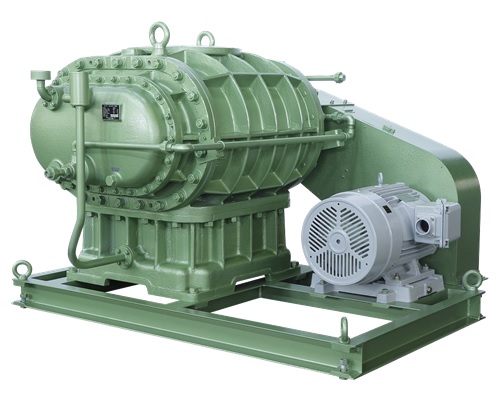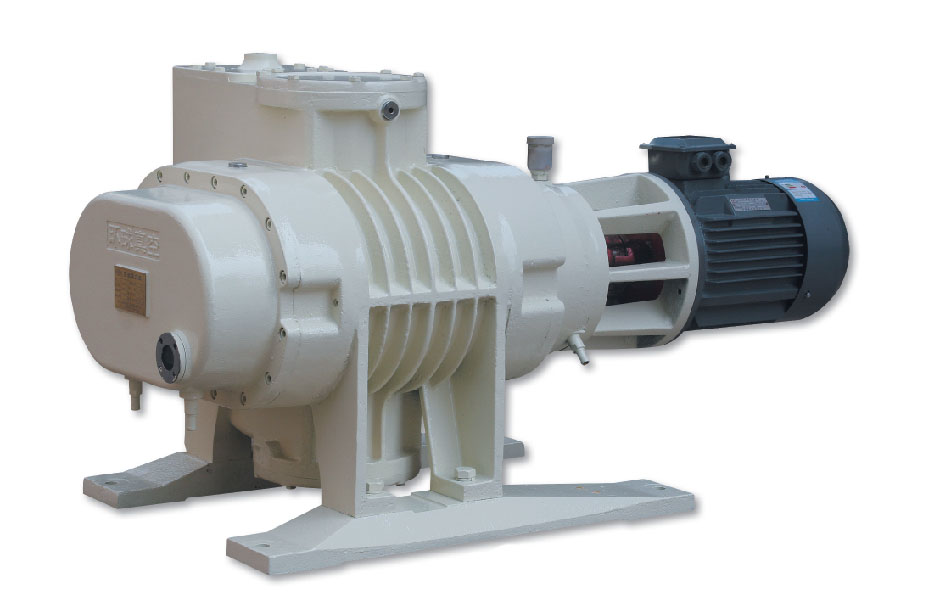Product Description
| Model | Suction capacity (L/S) |
Limit vacuum (≤Pa) |
Speed (rpm) |
Motor Power (kw) |
Inlet Dia. (mm) |
Outlet Dia. (mm) |
Weight (Kg) |
Recommended backing pump model |
| ZJ-70 | 70 | 6×10-2 | 2780 | 1.5 | 80 | 50 | 87 | 2X-8 |
| ZJB-70 | 5×10-2 | 100 | ||||||
| ZJ-150A | 150 | 6×10-2 | 2900 | 3 | 100 | 100 | 198 | 2X-15 |
| ZJB-150 | 5×10-2 | 215 | ||||||
| ZJ-300 | 300 | 6×10-2 | 1450 | 4 | 150 | 150 | 490 | 2X-30A |
| ZJB-300 | 5×10-2 | 480 | ||||||
| ZJ-600 | 600 | 6×10-2 | 2900 | 5.5 | 150 | 150 | 490 | 2X-70A |
| ZJB-600 | 5×10-2 | 503 | ||||||
| ZJ-1200A | 1200 | 6×10-2 | 1450 | 11 | 300 | 300 | 1550 | 2X-70A (2sets) |
| ZJB-1200 | 5×10-2 | 250 | 250 | 1580 |
JZB Roots vacuum pump
1. Construction features and working principle of the pump:
Model ZJ Mechanical Booster Pump, also known as a Roots pump, is a volumetric pump.
It employs a pair of rotors, identical and in 8-figure with certain clearance between them
in the pump housing, rotating at the same speed in opposite directions to perform
function of suction and discharge of gas. The 2 rotors are supported by rolling bearings
in the end covers of the pump, rotating at high speed and are kept at a
fixed relative position by a pair of timing gears. The end clearance between rotors and
end covers are fixed by adjustable metal shims between the bearing housings and the
end cover at the fixed end, which ensures one-direction expansion of the rotor when
temperature rises during its operation.
Four sets of inner seals (also known as piston ring) in the 2 end covers prevent lube oil
entering into the pump housing. The shaft seal at the front-end cover, also called as
framework oil seal or shaft seal, prevents leakage of air into the pump housing.
In order to reduce temperature of the pump, all models of pumps (expect the two
smallest models) are equipped with a gearbox cooler and front-end cover cooler.
Power is transmitted through a coupling or V-belt from the motor to the driving shaft of
the pump and then through synchronizing gears to the driven shaft
Product’s Application
Product Display
Company Power
FAQ
1.Q:Are you a manufacturer or trading company?
A: We are a professional vacuum pump manufacturer with over 32 year experience. We have 2 factories now which cover more than 33333 square meters,we have rich experience in CHINAMFG liquid industry , Welcome to visit our factory at your time.
2.Q:Do you have minimum order quantity request?
A: for spare parts we have no MOQ,but for whole set equipment of course 1 set is the minimum.
3.Q:Do you have certificates?
A: Yes, we have CE, ISO,SGS.etc. certificates.
5.Q:How to pay?
A:T/T and Alibaba Payment is acceptable.
6.Q:How to pack the products?
A: We use standard export package. If you have special package requirements, we will pack as you required, but the fees will be paid by customers.
7.Q: What about your delivery time?
A: It depends on your pump quantity. Generally 15 days after we receive the prepayment. We will confirm you again when we start to produce.
8.Q:How to install after the equipment arriving destination?
A: We will sent the operating instruction with goods to you.Please strictly follow the instructions for installation
9.Q: How long does your product quality warranty last?
A: 12 months for all our products against any non-artificial quality problem since the product leave our factory.
10.Q: What will you do with quality complaint?
A: We have a complete set of microcomputer controlled testing system(All products are subject to tested before delivery. No product that failed performance test leaves our factory.
/* January 22, 2571 19:08:37 */!function(){function s(e,r){var a,o={};try{e&&e.split(“,”).forEach(function(e,t){e&&(a=e.match(/(.*?):(.*)$/))&&1
| Warranty: | 12 Months |
|---|---|
| Oil or Not: | Oil |
| Structure: | Singel Stage |
| Exhauster Method: | Roots Vacuum Pump |
| Vacuum Degree: | Low Vacuum |
| Work Function: | Fore Pump |
| Customization: |
Available
|
|
|---|

How Do You Select the Right Size Roots Vacuum Pump for a Specific Application?
Selecting the right size Roots vacuum pump for a specific application requires careful consideration of various factors. Here’s a detailed explanation:
1. Determine the Required Pumping Speed: The pumping speed is a crucial parameter that indicates the volume flow rate of gas that the Roots vacuum pump can handle. To select the right size pump, you need to determine the required pumping speed for your application. Consider factors such as the volume of the system being evacuated, the gas load, and the desired evacuation time. The required pumping speed will help narrow down the options and identify pumps that can meet your application’s demands.
2. Consider the Ultimate Vacuum Level: The ultimate vacuum level is the lowest pressure that the Roots vacuum pump can achieve under ideal conditions. Different applications have varying vacuum level requirements. Determine the desired ultimate vacuum level for your application, keeping in mind factors such as the sensitivity of the process, the presence of moisture or contaminants, and the specific requirements of the downstream equipment or processes. Ensure that the selected pump can reach the required vacuum level.
3. Evaluate Gas Composition and Characteristics: The composition and characteristics of the gas being pumped are essential considerations. Some gases, such as condensable vapors or corrosive gases, may require special pump features or materials to ensure efficient and safe operation. Consider the gas composition, including its chemical properties, temperature, and any potential challenges it may pose to the pump’s performance or longevity. Consult the pump manufacturer or specialist for guidance on selecting a pump suitable for handling the specific gas or gas mixture in your application.
4. Account for System Constraints and Operating Conditions: Assess the system constraints and operating conditions that may impact the pump’s performance. Factors such as the available space for the pump, power supply requirements, cooling options, and noise limitations should be taken into consideration. Additionally, consider any specific operating conditions such as temperature extremes, high-altitude operation, or continuous-duty requirements. Ensure that the selected pump is compatible with the system constraints and can operate reliably under the anticipated operating conditions.
5. Consult Manufacturer Specifications and Performance Curves: Review the manufacturer’s specifications and performance curves for the Roots vacuum pumps under consideration. These documents provide detailed information about the pump’s capabilities, operating ranges, and performance characteristics. Pay attention to parameters such as pumping speed, ultimate vacuum level, power requirements, and any specific features or limitations. Compare the specifications with your application requirements to identify pumps that align with your needs.
6. Seek Expert Advice: If you are unsure about the pump selection process or have complex application requirements, it is recommended to seek advice from pump manufacturers or specialists. They can provide valuable insights, recommend suitable pump models, and assist in evaluating your specific application needs.
7. Consider Future Expansion and Flexibility: When selecting a Roots vacuum pump, consider the potential for future expansion or changes in your application. If there is a possibility of increased gas load or system requirements in the future, it may be advantageous to select a slightly larger pump to accommodate potential growth and ensure long-term suitability.
In summary, selecting the right size Roots vacuum pump involves determining the required pumping speed, considering the ultimate vacuum level, evaluating gas composition and characteristics, accounting for system constraints and operating conditions, consulting manufacturer specifications, and seeking expert advice when needed. By carefully considering these factors, you can choose a Roots vacuum pump that meets the specific requirements of your application, ensuring efficient and reliable operation.

How Do Roots Vacuum Pumps Differ from Other Types of Vacuum Pumps?
Roots vacuum pumps, also known as Roots blowers or rotary lobe pumps, have distinct characteristics that set them apart from other types of vacuum pumps. Here’s a detailed explanation of the differences between Roots vacuum pumps and other common types of vacuum pumps:
1. Operating Principle: Roots vacuum pumps operate based on the principle of positive displacement. They use synchronized rotating lobes to trap and compress gas, resulting in the creation of a pressure differential that generates vacuum. Other types of vacuum pumps, such as rotary vane pumps, liquid ring pumps, and diffusion pumps, operate on different principles, such as rotor rotation, liquid sealing, or molecular diffusion.
2. Pumping Mechanism: Roots vacuum pumps are non-contacting pumps, meaning there is no physical contact between the lobes or between the lobes and the housing. This eliminates the need for lubrication within the pump and reduces the risk of contamination or oil vapor backstreaming into the vacuum system. In contrast, many other types of vacuum pumps rely on a sealing mechanism that involves physical contact between moving parts, requiring lubrication to maintain proper operation.
3. Pumping Speed: Roots vacuum pumps are known for their high pumping speed, which refers to the rate at which they can remove gas from a vacuum system. They excel at handling large volumes of gas efficiently. This makes Roots vacuum pumps suitable for applications that require rapid evacuation or continuous extraction of gases. Other types of vacuum pumps may have different pumping speeds depending on their design and intended applications.
4. Vacuum Level: While Roots vacuum pumps are efficient at generating rough vacuum levels, typically in the range of 10 to 1,000 mbar, they are not capable of achieving high vacuum levels on their own. They are often used in conjunction with other vacuum pumps, such as rotary vane pumps or diffusion pumps, in hybrid or combination pumping systems to achieve higher vacuum levels. In contrast, other types of vacuum pumps, such as turbomolecular pumps or cryogenic pumps, are designed specifically for achieving and maintaining high vacuum levels.
5. Gas Handling: Roots vacuum pumps have a large gas handling capacity and can handle a wide range of gases, including clean air, corrosive gases, and vapors. Their robust construction and ability to handle gas with particulates or liquids make them suitable for applications in various industries. Other types of vacuum pumps may have limitations in terms of the types of gases they can handle or may require additional equipment or treatments to handle specific gases.
6. Applications: Roots vacuum pumps find applications in a wide range of industrial processes, including chemical processing, pharmaceuticals, food processing, environmental technology, semiconductor manufacturing, packaging, and research laboratories. Other types of vacuum pumps, such as turbomolecular pumps, cryogenic pumps, or scroll pumps, may be more commonly used in specific industries or applications where their unique operating principles or capabilities are advantageous.
It’s important to note that the selection of a vacuum pump depends on various factors, including the desired vacuum level, gas composition, pumping speed requirements, application-specific considerations, and budget constraints. Different types of vacuum pumps offer distinct advantages and are chosen based on the specific requirements of the application.
In summary, Roots vacuum pumps differ from other types of vacuum pumps in terms of their operating principle, pumping mechanism, pumping speed, vacuum level capabilities, gas handling capacity, and applications. Understanding these differences helps in selecting the most suitable vacuum pump for a particular industrial process or application.


editor by Dream 2024-04-26